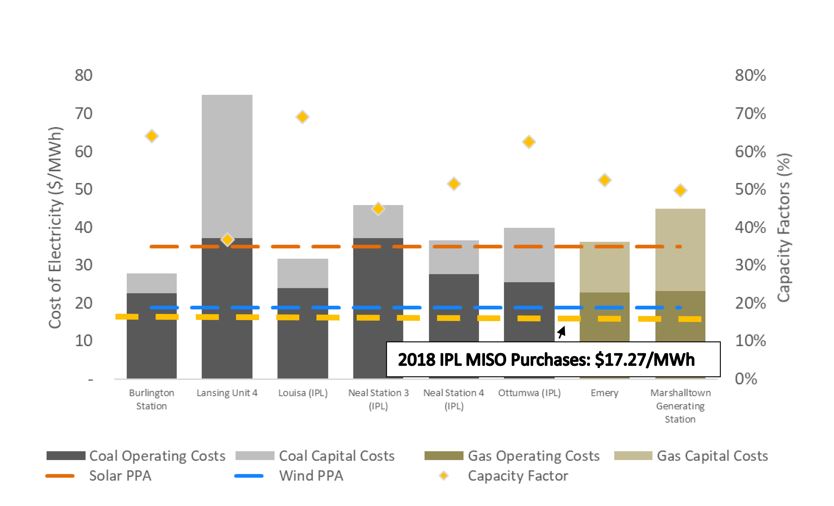Expert Analysis Finds Alliant Customers are Paying Too Much for Coal
posted
on Monday, August 12, 2019
in
Energy News
Analysis shows millions could be saved if Alliant replaced coal with renewable generation, market-purchased energy
DES MOINES – Expert testimony filed last week by The Iowa Environmental Council and Environmental Law and Policy Center in the Alliant Energy Rate Case currently before the Iowa Utilities Board highlights solutions that will save customers money while cleaning up Alliant’s generation mix.
Alliant Energy, a utility providing electric service to about 490,000 customers in Iowa, recently requested a 24% rate increase on residential customers from the Iowa Utilities Board – about $240 per year for the average household. The Iowa Environmental Council and Environmental Law & Policy Center (ELPC) filed testimony from five expert witnesses last week identifying a wide range of significant concerns with Alliant’s proposal.
A key finding: coal no longer makes economic sense in Iowa.
“Retiring Alliant’s uneconomic coal plants now and moving to renewable energy will save customers money. The economics show it is time for Alliant to walk away from coal, an outdated, dirty, and expensive energy source,” said Josh Mandelbaum, attorney with the Environmental Law and Policy Center.
Alliant Energy is a full or partial owner of nine coal power plants in Iowa, adding up to a total of 5,003 megawatts (MW) of total capacity. Though Iowa is a leader in energy generation from wind and renewable sources, coal generation remains the largest source of energy generation in Iowa.
Uday Varadarajan, Principal with the Rocky Mountain Institute based in Colorado, served as an expert witness on coal power for IEC and ELPC. Varadarajan’s analysis of fuel, operating costs, capital costs, and other costs at each plant showed that customers will pay more over time if Alliant continues to operate the coal plants, versus saving $16 million in the next year if Alliant closes three coal plants and replaces them with wind or open-market purchases.

Source: Varadarajan direct testimony, p. 10, citing IPL FERC Form 1, EIA 923, and DOE 2017 Wind Technologies Market Report. The analysis focused on six of the seven coal plants that Alliant owns or co-owns as well as two large gas plants that Alliant owns.
Varadarajan’s analysis concludes that Alliant’s customers would see significant savings if the utility immediately retired its share of three coal plants and replaced that energy with generation from renewable sources and power purchased from the MISO market. For the remaining plants, Varadarajan recommends using a range of tools to retire these plants as soon as possible.
“Continuing to operate these coal plants is forcing customers to pay more than they should. Alliant’s ongoing reliance on coal ignores the cheaper options of wind and solar,” said Kerri Johannsen, Energy Program Director at the Iowa Environmental Council.
Customers have been paying a portion of the 24% increase on their utility bills since spring, even while the requested increase follows the standard process. This is allowed by Iowa law. If the IUB denies the request or approves a smaller increase, Alliant would be required to refund customers. The Iowa Utilities Board will hear the case in October and make its final ruling by January 1, 2020.
Read more details on the coal plant analysis at IEC’s website.
###